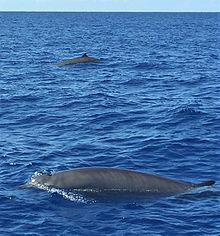Gervais' beaked whale
| Gervais' beaked whale | |
|---|---|
 |
|
 |
|
| Size compared to an average human | |
| Scientific classification | |
| Kingdom: | Animalia |
| Phylum: | Chordata |
| Class: | Mammalia |
| Order: | Artiodactyla |
| Infraorder: | Cetacea |
| Family: | Ziphiidae |
| Genus: | Mesoplodon |
| Species: | M. europaeus |
| Binomial name | |
|
Mesoplodon europaeus (Gervais, 1855) |
|
 |
|
| Gervais' beaked whale range | |
Gervais' beaked whale (Mesoplodon europaeus), sometimes known as the Antillian beaked whale, Gulf Stream beaked whale, or European beaked whale (from which its scientific name is derived) is the most frequently stranding type of mesoplodont whale off the coast of North America. It has also stranded off South America and Africa.
Sometime between 1836 and 1841, a captain of one of the ships of the French merchant and armorer Abel Vautier came across a large animal floating at the entrance to the English Channel, its body covered by swarming gulls. He cut the head off and transported it to Caen, where he presented it to Vautier. Vautier in turn offered it to the anatomist Deslongchamps. The specimen somehow made its way to the French scientist Paul Gervais, who described it as a new species in 1855. For several decades this remained as the only known specimen of this species, with many disregarding its specific status and claiming it merely represented an aberrant adult Sowerby's beaked whale. The species’ identity was confirmed by the discovery of two specimens from New Jersey, an immature male captured near Atlantic City in 1889 and an adult female found stranded at North Long Branch in 1905.
This species is the largest of the mesoplodonts and rather gracile, elongated, and laterally compressed compared with the others. The mouthline is remarkably straight, even in males, and the two teeth of the male erupt towards the tip of the beak, and are hardly noticeable. The head is overall small and tapering in outline. The melon only bulges very slightly. The coloration is dark gray on top and lighter gray on bottom. Females sometimes have lighter spots near the genitals and face, with a dark circle remaining around the eyes.images(external morphology, skull morphology, tooth morphology) Juveniles start off with a lighter coloration, but soon darken. Males are 4.5 meters (15 ft) in length and females are at least 5.2 meters (17 ft) and probably weigh more than 1200 kg (2600 pounds). Calves are believed to be 2.1 meters (7 feet) in length. One beached specimen may have been 48 years old.
Since the discovery of the type specimen, it has been found off the eastern coast of the United States, Ireland, the Canary Islands, western Africa, and Ascension Island. In August 2001, a specimen was found off São Paulo, Brazil; the southernmost specimen found to date. The species is believed to be naturally rare, and no estimates have been attempted.
...
Wikipedia

